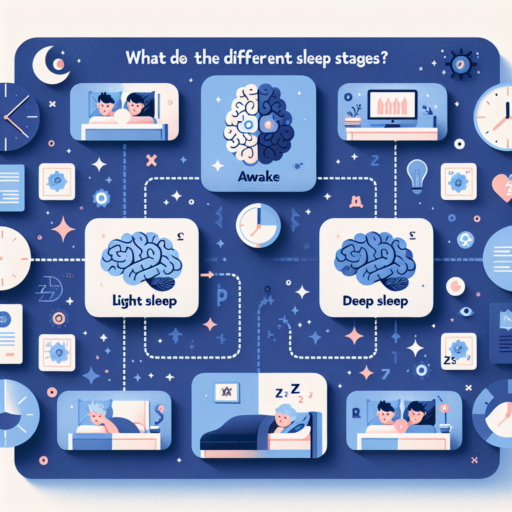What are the 5 stages of sleep?
Understanding the five stages of sleep is crucial for grasping how our body cycles through different phases during rest, affecting everything from physical recovery to memory consolidation. These stages are split between Rapid Eye Movement (REM) sleep and Non-Rapid Eye Movement (NREM) sleep, which each play distinct roles in our nightly rejuvenation.
The first four stages fall under NREM sleep, beginning with stage 1, a light sleep where you drift in and out of sleep easily and can be awakened without difficulty. This stage acts as a gateway to deeper sleep stages. Then, we transition into stage 2, characterized by a slowing down in both heart rate and brain waves, preparing the body for deep sleep. Stages 3 and 4 are the deep sleep phases, where the body undergoes significant repair and growth processes, and it becomes much harder to awaken. These stages are crucial for physical recovery, immune function, and energy restoration.
Finally, the fifth stage, known as REM sleep, marks a return to lighter sleep phases characterized by rapid eye movement, increased brain activity, and vivid dreams. This stage is essential for cognitive functions such as memory, learning, and emotional regulation. Each cycle through these stages lasts about 90 minutes, with REM sleep periods getting longer as the night progresses.
No se han encontrado productos.
How many hours of REM sleep do you need?
The question of how many hours of REM sleep you need is pivotal to understanding overall sleep quality and health. REM sleep, or Rapid Eye Movement sleep, is a critical phase in the sleep cycle associated with dreaming, memory consolidation, and mood regulation. It varies significantly across different age groups and even from person to person.
Generally, adults require about 20-25% of their sleep to be REM, which translates to roughly 1.5 to 2 hours of REM sleep per night. This stage tends to occur in cycles every 90 minutes or so after falling asleep. However, it’s not just the quantity but also the quality of REM sleep that’s essential for cognitive function and mental health.
The needs for REM sleep can alter due to various factors, including stress, lifestyle, and health conditions. Unlike children, who may require more REM sleep for development purposes, adults need to maintain a balance to ensure their brain functions optimally. Paying attention to the overall sleep hygiene can significantly enhance the efficiency of the REM sleep cycle.
What is the best sleep stage?
Understanding the complexity of sleep involves delving into the various stages that compose it, each with its unique characteristics and benefits. While all stages of sleep are essential for a restorative night’s sleep, discussions often center around identifying the «best» sleep stage. This query, however, may oversimplify the intricate nature of sleep, as the value of each stage depends on what the body and mind require for health and rejuvenation.
One sleep stage that frequently captures attention is the Rapid Eye Movement (REM) stage. This is when most dreaming occurs, and it plays a critical role in emotional regulation and memory consolidation. During REM sleep, the brain processes and synthesizes emotions, experiences, and information gathered throughout the day. Its importance in learning and mood regulation underscores why many experts consider it crucial for mental health.
Non-REM Sleep’s Impact
Conversely, the Non-REM (NREM) stages of sleep, particularly the deep sleep phase also known as slow-wave sleep, are equally vital. This stage is pivotal for physical recovery, growth and development, boosting immune function, and restoring the body’s energy reserves. The profound restorative functions of deep sleep underscore its undeniable importance in physical health and wellbeing.
What is REM vs deep sleep?
Understanding the distinction between REM (Rapid Eye Movement) sleep and deep sleep is crucial for comprehending our sleep cycles and its impact on our health. REM and deep sleep serve different but equally vital roles in our well-being, affecting everything from memory consolidation to the rejuvenation of our bodies.
Differences in Brain Activity
During REM sleep, brain activity increases, closely resembling that of being awake. This stage is associated with vivid dreams, due to heightened brain activity. Conversely, deep sleep is characterized by slow brain waves known as delta waves, indicating a state of minimal mental activity. It’s during deep sleep that the body undertakes the majority of its healing and regrowth, making it fundamental for physical health.
The Role in Memory and Learning
Both REM and deep sleep play integral roles in memory consolidation and learning. REM sleep is particularly crucial for consolidating procedural memories and emotional processing. In contrast, deep sleep is essential for the consolidation of declarative memories, critical for learning new information and skills. Balancing these two stages is key for optimal cognitive function and overall mental health.
In sum, the contrast between REM and deep sleep highlights the complexity of our sleep needs. By understanding these differences, we can better appreciate the importance of a balanced sleep cycle for our physical and cognitive well-being.




